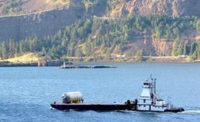Vast amounts of low-level radioactive waste could be transported to a West Texas site if a commission made up mostly of Gov. Rick Perry appointees decides that Texas can accept such waste from 36 or more states.
The Texas Low-Level Waste Disposal Compact Commission, established by a federal statute encouraging states to make deals for disposing of LLRW, is run jointly by six Texans and two Vermont members. It could decide as early as June if Texas can import the waste from outside the compact.
The commission postponed a May 11 meeting that could have led to a vote on the so-called export-import rule after public opposition was heard and 15 Texas state legislators wrote to the agency on May 4 urging it not to adopt the rule until further consideration could be given to liability issues as well as public health and safety.
“Texas and Vermont waste generators have been disposing of Class A-LLRW in Clive, Utah,” says Susan Jablonski, head of the radioactive materials division of the Texas Commission on Environmental Quality. “Under federal law, states are responsible for the LLRW generated within their borders.”
“The commissioners are having a high-level public debate on this issue,” says Katherine Cesinger, Perry’s deputy press secretary. “And considering all the comments they’ve received on the proposed rule, the governor expects them to ultimately make a decision that is in the best interest of Texas.”
Karen Hadden, executive director for the Sustainable Energy & Economic Development Coalition, a statewide nonprofit based in Austin, says the coalition is concerned that the commission has no technical data. “They’re coming at it with ‘How can we make this dump profitable?’” Hadden says.
“That’s not their charge. They are supposed to be looking at economic and health and safety factors.”
Although a final decision is pending, Waste Control Specialists LLC, Dallas, a hazardous waste operator with a dump in Andrews County, in far West Texas, is moving ahead with construction for the LLRW facility that the state would own. “We expect to begin construction in June and the site to be operational in spring 2011,” says William P. Dornsife, executive vice president for licensing and regulatory affairs for Waste Control.
Harold Simmons, owner of WCS and a longtime Perry supporter and contributor, has said the project has the potential to make $100 million a year for WCS. Some estimate it could earn billions. A $75-million bond package passed by just three votes in Andrews County in 2008 will pay for the project.
Dornsife says the firm is in the process of selecting one of three contractors to build the facility, expected to cost about $80 million. The company is already licensed by the TCEQ for a LLRW disposal facility, although technical deficiencies must be addressed before construction begins. “There are pending conditions of the license and an amendment currently being processed by the agency,” Jablonski says.
Disposal of LLRW is regulated by the TCEQ. Nuclear power plants contribute the largest portion of LLRW in the form of metals and other hardware. It also includes waste from health-care and research laboratories. LLRW does not include waste from nuclear weapons manufacturing.
Hadden says “low-level does not mean low-risk” and can include every single radionuclide identified by the Nuclear Regulatory Commission. “What would actually go are nuclear reactors, everything except fuel rods, and a small volume of medical waste,” she adds.
SEED and others believe there could no limits on the import rule. “They [the commissioners] are unwilling to put a sentence [in the rule] saying the license limits supply,” Hadden says. “We are concerned that this import rule is an invitation to states from across the U.S. to dump here.” She calls it a “back-door way” of forcing the license to expand at the TCEQ.


Post a comment to this article
Report Abusive Comment